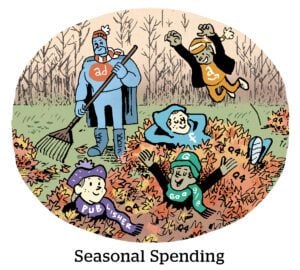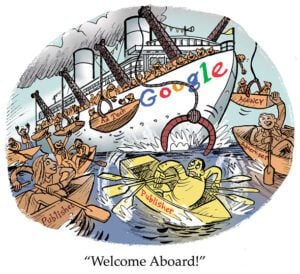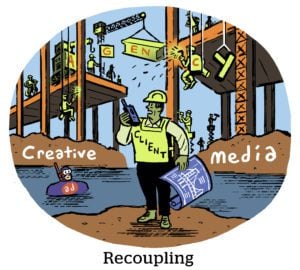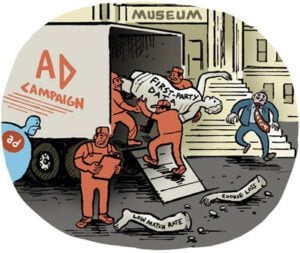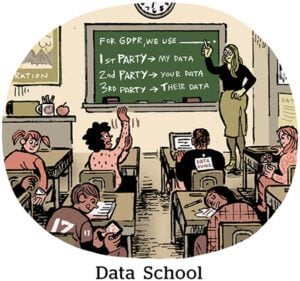YouTube Shorts is no longer just a shiny new object to marketers.
And that’s because YouTube has finally been addressing their biggest ask: to unbundle Shorts from other YouTube inventory.
YouTube first launched its TikTok copycat product in 2020 and introduced ad opportunities by 2022. But, until recently, marketers haven’t been able to plan specific campaigns for Shorts because the inventory couldn’t be bought separately from other YouTube supply, said Brian Binder, senior director of programmatic at Tinuiti.
When inventory is bundled, buyers have little way of knowing whether their ads are running on a connected TV, desktop or mobile device. Buyers also struggle to compare how Shorts perform compared to the rest of their media mix.
To address their frustration, YouTube started creating ways for marketers to feature Shorts in their YouTube ad buys, starting with a new product suite that includes the option to run YouTube ads between top-viewed Shorts. Shortly thereafter (pun intended), it quietly set up a pilot program in alpha testing over the summer that lets brands specifically buy Shorts supply through a handful of Google Premier Partners. (Prior to this pilot, new ad buying options for Shorts were still part of a bundle.)
Certain ad buying options for Shorts, such as running ads between top-viewed Shorts and reserving the first ad opportunity in a Shorts scrolling session, are now in beta testing, a YouTube spokesperson told AdExchanger.
Now that the pilot program has been running for several months, Binder said, brands can see how Shorts ads actually perform, including giving them the ability to reach new audiences they may not necessarily hit with traditional YouTube campaigns.
Melissa Hsieh Nikolic, YouTube’s director of product management, told AdExchanger that marketers are seeing positive ROI and engagement from running ads on Shorts and that early results of the pilot program demonstrate strong reach and brand lift. She didn’t share specific numbers, however.
In short order
Part of the reason Shorts drives incremental reach is because viewers watch short-form video on YouTube for a different reason than they consume other video on the platform or more traditional video content.
Watching YouTube videos or TV shows is more of a lean-back experience, whereas Shorts emulates social media platforms with vertical video and a scrolling interface. Think along the lines of TikTok and Reels on Facebook or Instagram. As a result, Shorts likely sit lower in the purchase funnel compared with more traditional TV viewing.
Because Shorts content looks and feels more like social media, ads that feel native – as in, user-generated content that features influencers talking about particular brands – perform “substantially better” compared with classic 15- and 30-second spots, Binder said.
For Shorts to help brands attract new customers, their ads can’t look and feel too much like, well, ads.
Staying on target
Although it’s not clear when YouTube will open up its new ad buying options for Shorts more widely, it’s a good bet to assume that the ability to unbundle Shorts will eventually be a generally available buying feature.
According to Binder, more advertiser clients want to add Shorts ads to their media mix as a natural “extension” of what they’re already doing on social media.
But, although unbundling addresses one pain point, advertisers have another request: better targeting options.
Targeting for Shorts is more so based on contextual signals like content category, rather than more specific audience data.
YouTube released new ways to target ads on Shorts last year, including allowing advertisers to run ads only in Shorts with the most views. But targeting top-viewed Shorts is currently available through direct deals only, according to companies that participated in the pilot program, so brands aren’t able to layer in much data of their own.
Buyers can target Shorts based on content genre, such as gaming or cooking, but they can’t yet target specific channels or videos, said Denis Crushell, chief commercial officer of kid-focused video ad platform Precise TV.
As one of Google’s Premier Partners, Precise TV can help brands include more data in their YouTube buys, including Shorts. For example, advertisers can target YouTube ads based on Google keywords for audiences over 13. If someone is searching for recipes online, say, Precise can help brands reach those users on cooking-related videos within seven days of the initial search.
Precise also licenses retail data from panel providers to help marketers target ads within content categories popular with customers over 13 that buy certain types of products. Precise declined to name the data providers it works with for this offering.
Brands that see the most success on Shorts use multiple ad creatives and pay attention to which keywords resonate best with which audiences, Crushell said.
In it for the long haul
Whichever way brands choose to target, though, the purpose of investing in any new channel is to drive some sort of business outcome.
For example, although view-through rates are naturally lower for Shorts compared with classic YouTube because of the scrolling element, a social-media-inspired content strategy plus some interest-based targeting can still help brands improve their view-through rate on Shorts.
Take Moose Toys, a children’s toy brand that works with Precise TV to target ads for children’s toys to parents through Shorts.
Shorts were “a big part of our parent-targeted media mix last year,” said Alison Allen, digital marketing manager of Moose’s European business. Now that the brand can run targeted Shorts ads, specifically, it can measure how those ads are performing based on view-through rate and incremental reach.
One campaign had a view-through rate that was 75% higher than expected based on Precise TV’s benchmark for Shorts.
Other advertisers are also encouraged by the results they’re seeing from Shorts ads. “Now that we’re able to see performance for YouTube Shorts, it’s definitely becoming more of a staple in our clients’ media buying approach,” Binder said.
By that logic, expect brands to spend more on YouTube Shorts when specific targeting and measurement move beyond the testing phase and become publicly available.
YouTube declined to share its timeline for general availability.




